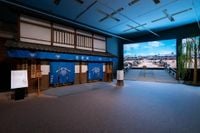At the Tokyo National Museum's Heisei Building, an exhibition titled "Sharaku Tsutaya Juzaburo: The Tempest of Content Business" is currently captivating visitors. This showcase highlights the remarkable contributions of Tsutaya Juzaburo, a pivotal figure in the Ukiyo-e publishing world during the Kansei era (1789-1801). Tsutaya not only entered the realm of Ukiyo-e but also discovered and promoted renowned artists such as Kitagawa Utamaro, Tōshūsai Sharaku, and Eishōsai Chōki, planning and publishing works that maximized their appeal.
One of the standout features of Utamaro's works is the "Okubie" or large-head picture structure. This technique focused on close-ups of people's faces, allowing Utamaro to accentuate the individuality of women. His series of portraits depicting beautiful women became a major hit, capturing the emotions of women from various social classes, including courtesans and teahouse waitresses. According to art historian Matsushima, "Utamaro's beautiful large-head picture series became a major hit, depicting the emotions of women from various social classes."
Sharaku, another celebrated artist from this era, is also a focal point of the exhibition. Known for his striking actor prints, Sharaku employed the same large-head composition style. Despite his brief career of just over ten months, he produced around 140 works before disappearing from the historical record. Once regarded as a mysterious artist, it is now widely accepted that Sharaku was likely the actor Saito Jurobei, who was affiliated with the Hachisuka clan of Awa Tokushima.
Sharaku's works enjoy immense popularity overseas. German art historian Julius Kurth introduced him as one of the world's three great portrait artists alongside Rembrandt and Velázquez in his 1910 book "Sharaku." Tsutaya's publication of Sharaku's works in 1794, when he was 45 years old, is often cited as one of his greatest achievements. Matsushima notes, "If I were to highlight Tsutaya's best work among his diverse business ventures, it would be the introduction of Sharaku to the world."
The exhibition features notable works, including the important cultural property "The Third Otani Oniji as Edohei," which is a quintessential actor print. This piece captures a moment from the play "Koi Nyobo Sometsuke Tazuna," showcasing the intense gaze of the villain Edohei and his menacing open palm.
Another significant work on display is the important cultural property "Ichikawa Ebizo as Takemura Sadanosuke." This print features the renowned kabuki actor Ichikawa Ebizo, who was celebrated as one of the leading actors of his time. Sharaku vividly portrays Ebizo's robust physique, deep facial features, and commanding presence.
What is it that makes Sharaku so beloved worldwide? Matsushima explains, "Sharaku's true identity is Saito Jurobei, an actor. If he were merely an artist, he would have beautified the actors he portrayed. However, as an actor himself, Sharaku depicted the true essence of his subjects, giving his works a real sense of power and presence."
The exhibition also showcases the "Gakyō Project," a contemporary woodblock print initiative by StarSeas, which is being exhibited at the Tokyo National Museum's Hyokeikan as part of the "Ukiyo-e NOW" exhibition. This project commemorates the 260th anniversary of Katsushika Hokusai's birth and was launched in Sumida Ward, Hokusai's birthplace.
The "Gakyō Project" invites contemporary manga artists to create original drawings for woodblock prints, continuing the traditional Ukiyo-e production techniques from the Edo period. Ten artists, including Yuichi Ikehata, Rieko Ikeda, Ilya Kuvshinov, Fumiyo Kouno, Saito Takao, Machiko Satonaka, Tetsuya Chiba, Baron Yoshimoto, and Yoshitomo Yasuhiko, each express their interpretation of "Ukiyo" through their works.
The "Ukiyo-e NOW" exhibition, which runs from April 22 to June 15, 2025, is divided into five chapters. The first chapter, "Manga Ōkan," showcases modern Ukiyo-e created by manga artists, featuring familiar characters engaging with the traditional woodblock print world. These works are produced through a division of labor similar to that of the Edo period, reflecting a deep respect for the Ukiyo-e masters.
The second chapter, "Hokusai Tribute," highlights the rediscovery of woodblocks from Hokusai's design drawings in the Boston Museum of Fine Arts collection, which were printed again by modern artisans. This discovery inspired contemporary Japanese designers to create works that resonate with Hokusai's exceptional design sense.
Subsequent chapters explore the varied woodblock prints created by designers, architects, and illustrators, as well as the collaborative efforts of artists worldwide with Japanese craftsmen since the 2010s. The fifth chapter, "Inheritance and Development," showcases woodblock prints curated by the Adachi Traditional Woodblock Print Preservation Foundation.
Visitors are encouraged to experience this unique opportunity to view the exquisite works produced by the "Gakyō Project" and other remarkable pieces that celebrate the rich heritage of Ukiyo-e. The exhibition is open from 9:30 AM to 5:00 PM, with extended hours until 8:00 PM on Fridays and Saturdays. Admission is allowed until 30 minutes before closing, and the museum is closed on Mondays.
As the exhibition continues to draw attention, the anticipation grows for the upcoming portrayal of Sharaku in an upcoming historical drama, expected to air in the fall. The public eagerly awaits how this enigmatic figure will be depicted on screen.
For those interested in exploring the fascinating world of Ukiyo-e, the "Sharaku Tsutaya Juzaburo: The Tempest of Content Business" exhibition runs until June 15, 2025, at the Tokyo National Museum's Heisei Building.




